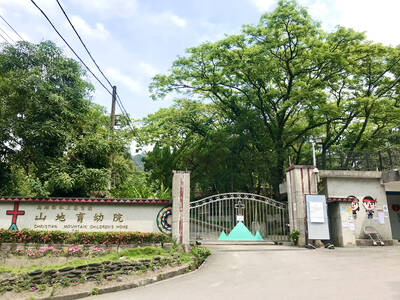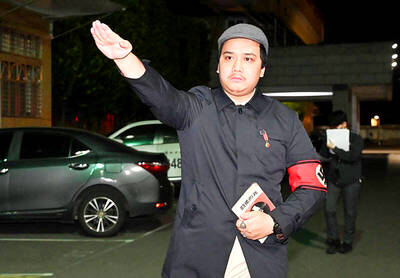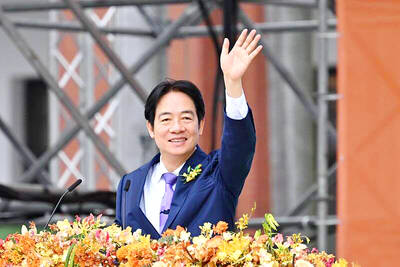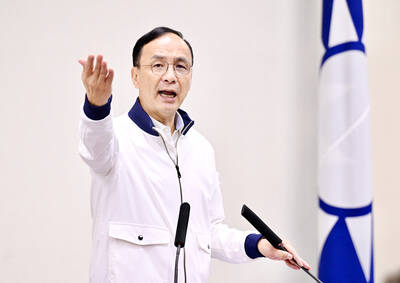A handsome but controversial young Tibetan lama has emerged on the local music scene by releasing his first CD — a collection of rap and hip-hop songs that he claims can help promote Buddhism.
Singa Rinpoche (盛噶仁波切), 30, who is barred from entering Taiwan due to his flamboyant behavior on a visit to the island last year, released the CD — Wish You Well (我要你幸福) — on Saturday through Taiwanese Forward Music company.
Since then, several TV channels have been airing the MTV spots promoting Singa's album — showing Singa recording songs in the studio, running in a forest and releasing a bird into freedom.

PHOTO COURTESY OF FORWARD MUSIC
Wearing his trademark white shirt and blue pants, Singa, 179cm tall and weighing 63kg, shows a natural talent for performing by flashing smiles and making poses, showing off his youth and confidence.
Singa signed a contract with Forward Music last April and began recording at a Beijing studio in July.
"We were surprised by the public response to this CD. It is selling extremely well. We have opened a blog for Singa Rinpoche and within a week, 100,000 people have browsed it," a Forward Music (豐華唱片) press officer said.
Most of the 12 songs on the CD were written and composed by a Taiwan musician and two were written and composed by Singa.
They are: Reincarnation, Wish You Well, Let Me Take Care of You, Fashion, It's the Light, Girl Quji Zhuoma, Starting to Realize, Leave Love to You, Today, Lama Chino.
In the songs, Singa mixes rap and hip-hop with chants of Buddhist sutras, and switches from Chinese to Tibetan and English.
The songs deal mostly with love, but he also preaches his philosophy. The song Leave Love to You has this rap line: All the pain in this world is caused by seeking happiness for himself/All the joy in this world is caused by seeking happiness for others.
Born in Qinghai Province, China, in 1970, Singa claims a rainbow appeared in the sky when he was born. At 16, a Tibetan monastery confirmed he was the reincarnation of a high lama.
Singa claimed he spent three years studying Buddhism in Nepal, Tibet and Thailand, before traveling around the world to spread Buddhism.
But when he visited Taiwan from February to April last year to promote his book, This Is Me, a living Buddha, he caused controversy because he acted more like a film star than a monk. He wore trendy clothes and received his disciples wearing a shirt and jeans, not the red cloak worn by Tibetan lamas.
Some Taiwan disciples alledged Singa had not finished Buddhist studies in India and had not been ordained, prompting the Interior Ministry to bar him from entering the country for one year.
Cheng Chen-huang (鄭振煌), a internationally recognized Buddhist scholar, believes Singa Rinpoche has violated Buddhist precepts, or moral codes.
"There are 250 precepts for a Chinese Buddhist and 253 precepts for a Tibetan Buddhist. For a Buddhist, these codes are very important and must be observed," Cheng said.
Agga Wandha, a 59-year-old Burmese monk in Taipei, agreed.
"The essence of Buddhism is to quench desires in order to achieve inner peace. Singa Rinpoche's wearing fashionable clothes and driving fancy cars shows he is feeding these desires," he said.
But Singa Rinpoche's behavior is nothing new to Tibetan Buddhism. Three hundred years ago, the sixth Dalai Lama raised eyebrows because he frequented Lhasa's red light district at night and wrote love poems.
A more recent example is Dzongsar Khyentse Rinpoche from the Himalayan Buddhist kingdom of Bhutan, who directed two films — The Cup in 1999 and Travellers and Magicians in 2005.
Dzongsar Khyentse received world acclaim for his films and continues to travel around the world to preach Buddhism.

May 18 to May 24 Pastor Yang Hsu’s (楊煦) congregation was shocked upon seeing the land he chose to build his orphanage. It was surrounded by mountains on three sides, and the only way to access it was to cross a river by foot. The soil was poor due to runoff, and large rocks strewn across the plot prevented much from growing. In addition, there was no running water or electricity. But it was all Yang could afford. He and his Indigenous Atayal wife Lin Feng-ying (林鳳英) had already been caring for 24 orphans in their home, and they were in

On May 2, Chinese Nationalist Party (KMT) Chairman Eric Chu (朱立倫), at a meeting in support of Taipei city councilors at party headquarters, compared President William Lai (賴清德) to Hitler. Chu claimed that unlike any other democracy worldwide in history, no other leader was rooting out opposing parties like Lai and the Democratic Progressive Party (DPP). That his statements are wildly inaccurate was not the point. It was a rallying cry, not a history lesson. This was intentional to provoke the international diplomatic community into a response, which was promptly provided. Both the German and Israeli offices issued statements on Facebook

President William Lai (賴清德) yesterday delivered an address marking the first anniversary of his presidency. In the speech, Lai affirmed Taiwan’s global role in technology, trade and security. He announced economic and national security initiatives, and emphasized democratic values and cross-party cooperation. The following is the full text of his speech: Yesterday, outside of Beida Elementary School in New Taipei City’s Sanxia District (三峽), there was a major traffic accident that, sadly, claimed several lives and resulted in multiple injuries. The Executive Yuan immediately formed a task force, and last night I personally visited the victims in hospital. Central government agencies and the

Australia’s ABC last week published a piece on the recall campaign. The article emphasized the divisions in Taiwanese society and blamed the recall for worsening them. It quotes a supporter of the Taiwan People’s Party (TPP) as saying “I’m 43 years old, born and raised here, and I’ve never seen the country this divided in my entire life.” Apparently, as an adult, she slept through the post-election violence in 2000 and 2004 by the Chinese Nationalist Party (KMT), the veiled coup threats by the military when Chen Shui-bian (陳水扁) became president, the 2006 Red Shirt protests against him ginned up by